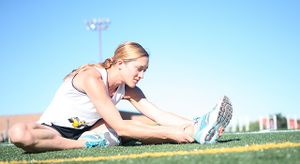Stretching
This article or area is currently under construction and may only be partially complete. Please come back soon to see the finished work! (1/06/2019)
Original Editor - Your name will be added here if you created the original content for this page.
Lead Editors
Purpose[edit | edit source]
Stretching exercises have traditionally been included as part of a training and recovery program. Evidence shows that physical performance in terms of maximal strength, number of repetitions and total volume are all affected differently by the each form of stretching – static stretch (SS), dynamic stretch (DS) and Proprioceptive Neuromuscular Facilitation stretching (PNFS).[1]
Stretching can help improve flexibility and range of motion about your joints. Improved flexibility may:
Improve your performance in physical activities
Decrease your risk of injuries
Help your joints move through their full range of motion
Enable your muscles to work most effectively[2]
Technique[edit | edit source]
Static Stretching (SS):[edit | edit source]
Static stretching is a type of stretching exercises in which elongation of muscle with application of low force and long duration (usually 30 sec). Static stretching has a relaxation, elongation effect on muscle, improving range of motion (ROM) , decreasing musculotendinous stiffness and also reduces the risk of acute muscle strain injuries.[3]
Dynamic Stretching:[edit | edit source]
DS involves the performance of a controlled movement through the available ROM. For a number of reasons, DS is sometimes considered preferable to SS in the preparation for physical activity. A close similarity to DS is warm up arm swings or leg swings.
DS activities help elevate core temperature increasing: nerve conduction velocity; muscle compliance and enzymatic cycling; accelerating energy production. DS more likely increase rather than decrease central drive, as may occur with prolonged SS.[1]
Proprioceptive Neuromuscular Facilitation Stretching (PNFS):[edit | edit source]
Multiple PNF stretching techniques exist, all of them rely on stretching a muscle to its limit. This triggers the inverse myotatic reflex, a protective reflex that calms the muscle to prevent injury. Regardless of technique, PNF stretching can be used on most muscles in the body. PNFS can also be modified so you can do them alone or with a partner.[4]
The below video gives a brief description of the types of stretching ( isometric stretching here is similar to PNFS)
Evidence[edit | edit source]
Provide the evidence for this technique here
Resources[edit | edit source]
add any relevant resources here
References[edit | edit source]
- ↑ 1.0 1.1 POGO An evidence based guide to stretching Available from: https://www.pogophysio.com.au/blog/performance-maximisation/ (last accessed 1.6.2019)
- ↑ Mayo Clinic Stretching Available from: https://www.mayoclinic.org/healthy-lifestyle/fitness/in-depth/stretching/art-20047931 (last accessed 1.6.2019)
- ↑ Physiopedia Impact of static stretching on muscle performance Available from: https://www.physio-pedia.com/Impact_of_Static_Stretching_on_Performance (last accessed 1.6.2019)
- ↑ Healthline PNF stretching Available from: https://www.healthline.com/health/fitness-exercise/pnf-stretching#pnf-techniques (last accessed 1.6.2019)
- ↑ Rachael Goepper Types of stretching Available from: https://www.youtube.com/watch?v=3V_L7ArBn_A (last accessed 1.6.2019)







